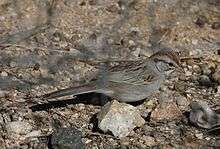Rufous-winged sparrow
The rufous-winged sparrow (Peucaea carpalis) is a medium-small, long-tailed American sparrow with a gray face and rusty crown and supercilium; the rufous lesser coverts of the wing for which it is named are often concealed.
| Rufous-winged sparrow | |
|---|---|
 | |
| Scientific classification | |
| Kingdom: | Animalia |
| Phylum: | Chordata |
| Class: | Aves |
| Order: | Passeriformes |
| Family: | Passerellidae |
| Genus: | Peucaea |
| Species: | P. carpalis |
| Binomial name | |
| Peucaea carpalis (Coues, 1873) | |
| Subspecies | |
|
Peucaea carpalis carpalis | |
| Synonyms[2] | |
|
Aimophila carpalis | |
Description
The back is brown with darker streaks, while the belly is pale gray. The wings and crown are rust-colored. This sparrow has a conical, yellow-based bill and a long brown tail.
Distribution and habitat
P. carpalis is a year-round resident from south-central Arizona and Guadalupe Canyon, New Mexico, south to northern Sinaloa, Mexico.
The rufous-winged sparrow inhabits desert grasslands with scattered mesquite or cholla. It also occurs in washes with sandy bottoms and vegetated slopes, brushy irrigation ditches, and creeks bordered by broad-leaved trees, mesquite, grasses, and forbs.
Diet
During the breeding season, adult rufous-winged sparrows feed on a variety of insects, caught on the wing or gleaned off plant surfaces. At other times, the bird eats seeds.
Breeding
Rufous-winged sparrows usually breed during the monsoon months of July and August. The nest is built low in small trees, bushes, or cactus, including hackberry, palo verde, cholla, and mesquite. The average clutch size is four; pairs may have two broods per year.
Status
This species is listed as a migratory bird under the Migratory Bird Treaty Act.
History in Pima County, Arizona
The rufous-winged sparrow in Pima County: This species was discovered by Charles Emil Bendire in 1872, near old Fort Lowell, Tucson, where it was common. In 1881, the sparrow was found "sparingly about Tucson and Camp Lowell. It inhabited the mesquite thickets, keeping closely hidden in the bunches of 'sacaton' grass, from which, when flushed, it flew into the branches above."
By the late 1880s, the species was probably extirpated from Arizona, perhaps as a result of overgrazing. The species began to recover in the United States around 1936, and is now found in appropriate habitat throughout much of eastern Pima County, Santa Cruz County, and western Cochise County. Loss of habitat as a result of overgrazing and urban development is believed to have had the greatest effect on populations.
References
- BirdLife International (2012). "Peucaea carpalis". IUCN Red List of Threatened Species. 2012. Retrieved 26 November 2013.CS1 maint: ref=harv (link)
- "Peucaea carpalis". Avibase.
- "Aimophila carpalis". Integrated Taxonomic Information System. Retrieved 24 February 2009.
Further reading
- Books
- Lowther, P. E., K. D. Groschupf, and S. M. Russell. 1999. Rufous-winged Sparrow (Aimophila carpalis). In The Birds of North America, No. 422 (A. Poole and F. Gill, eds.). The Birds of North America, Inc., Philadelphia, PA.
- Theses
- Groschupf KD. Ph.D. (1983). Comparative study of the vocalizations and singing behavior of four Aimophila sparrows. Virginia Polytechnic Institute and State University, United States, Virginia.
- Ohmart RD. Ph.D. (1969). Physiological and ethological adaptations of the rufous-winged sparrow (Aimophila carpalis) to a desert environment. University of Arizona, United States, Arizona.
- Articles
- Austin GT & Ricklefs RE. (1977). Growth and Development of the Rufous-Winged Sparrow Aimophila-Carpalis. Condor. vol 79, no 1. p. 37-50.
- Borror DJ. (1971). Songs of Aimophila Sparrows Occurring in the USA. Wilson Bulletin. vol 83, no 2. p. 132-151.
- Coues, E. (1873). "Some United States birds, new to science, and other things ornithological." American Naturalist 7: 322-323.
- Deviche P, McGraw K & Greiner EC. (2005). Interspecific differences in hematozoan infection in sonoran desert Aimophila sparrows. Journal of Wildlife Diseases. vol 41, no 3. p. 532-541.
- Deviche P & Small T. (2006). Non-photic environmental control of post-breeding reproductive regression and molt in a Sonoran desert passerine, the Rufous-winged Sparrow. Journal of Ornithology. vol 147, no 5. p. 55-55.
- Deviche P, Small T, Sharp P & Tsutsui K. (2006). Control of luteinizing hormone and testosterone secretion in a flexibly breeding male passerine, the Rufous-winged Sparrow, Aimophila carpalis. General and Comparative Endocrinology. vol 149, no 3. p. 226-235.
- Deviche P, Small TW & Sharp P. (2005). Food composition modulates photoinduced IH secretion in a flexibly breeding passerine. Hormones & Behavior. vol 48, no 1.
- Small T, Deviche P, Sharp PJ, Bentley GE, Millar RP & Tsutsui K. (2004). Supplementary information, not photoperiod, regulates plasma luteinizing hormone in male rufous winged sparrows, Aimophila carpalis. Integrative and Comparative Biology. vol 44, no 6. p. 748-748.
- Small TW & Deviche P. (2001). Environmental control of seasonal reproduction in a temporally variable breeder, the rufous-winged sparrow, Aimophila carpalis. Hormones & Behavior. vol 39, no 4.
- Small TW, Deviche P & Sharp P. (2003). Conspecific and heterospecific song exposure accelerates photoinduced reproductive development in the flexibly breeding Rufous-winged Sparrow, Aimophila carpalis. Integrative and Comparative Biology. vol 43, no 6. p. 927-927.
- Small TW, Deviche P, Sharp PJ, Bentley GE, Millar RP & Tsutsui K. (2005). The rapid reproductive response of male rufous-winged sparrows, aimophila carpalis, to increased precipitation: A role for termites?. Hormones and Behavior. vol 48, no 1. p. 128-128.
- Strand CR, Small TW & Deviche P. (2004). Singing in the rain: Growth of the song control system in free-ranging adult male Rufous-winged sparrows, Aimophila carpalis. Integrative and Comparative Biology. vol 44, no 6. p. 750-750.
- Zerba E & Baptista LF. (1980). Courtship Feeding in Some Emberizine Finches. Wilson Bulletin. vol 92, no 2. p. 245-246.
